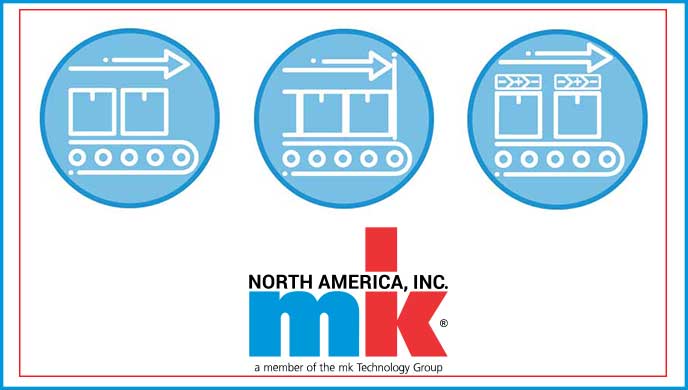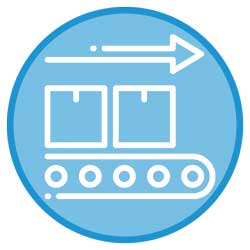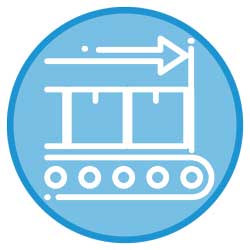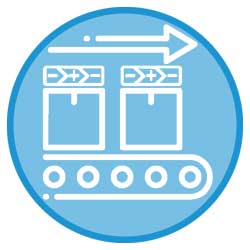Conveyor Modes of Operation
Posted on

How Product Characteristics Affect Conveyor Mode of Operation
Product Characteristics and Conveyor Selection
Conveyors come in many different styles and configurations and they move product from place to place. Conveyors can move it on a belt, chain or roller, to name a few. They can also move product horizontally, up inclines, and vertically. Conveyors can be reciprocating or move product around corners as well. But did you also know that conveyors are responsible for HOW product is delivered? Continue reading to learn about the three main modes of conveyor operation.
The three main modes of conveyor operation are:
- Continuous
- Accumulation
- Indexed
Conveyor operation relates directly to motor duty and load cycle. For the conveyor application engineer to select the most appropriate motor for the conveyor, they need to know which of these three modes of operation the conveyor is functioning in — in addition to conveyor loading and speed. For all conveyor applications, the maximum load and speed must be known but depending on the mode, additional information may also be required. So, let’s dive into what these conveyor modes of operation mean.
Continuous Conveyor Operation
 Continuous conveyor operation is also referred to as steady operation. This is the most common and fundamental mode of operation. Product comes onto the conveyor, is carried by the conveyor, and exits off the conveyor. In the most basic of examples, the product is conveyed from one end to the next end of the conveyor. However continuous operation is possible with product entering and exiting at different points along the conveyor lengths. As long as the product doesn’t stop on the conveyor while the conveyor continues to run AND as long as the conveyor doesn’t cycle on and off — then the mode of operation is continuous. If either of these things happens, then you are using one of the operation modes below.
Continuous conveyor operation is also referred to as steady operation. This is the most common and fundamental mode of operation. Product comes onto the conveyor, is carried by the conveyor, and exits off the conveyor. In the most basic of examples, the product is conveyed from one end to the next end of the conveyor. However continuous operation is possible with product entering and exiting at different points along the conveyor lengths. As long as the product doesn’t stop on the conveyor while the conveyor continues to run AND as long as the conveyor doesn’t cycle on and off — then the mode of operation is continuous. If either of these things happens, then you are using one of the operation modes below.
Accumulation Conveyor Operation
 In accumulation or accumulating conveyor operation, the product is stopped on the conveyor, and the conveyor continues to run under it. This is very common in pallet-handling conveyor systems, and all of the various pallet-handling conveyor platforms offer standard stopping modules. These stopping modules are either pneumatically or electrically activated – which means they are designed to either let the pallet pass over without stopping or engage with the pallet to stop it. But it’s not just pallets that can accumulate on conveyors. Product can also easily accumulate. The stop that holds back the product can be static and fixed to the conveyor, or it can be a pneumatic or electrical device similar to a pallet stop but designed to work with the specific product.
In accumulation or accumulating conveyor operation, the product is stopped on the conveyor, and the conveyor continues to run under it. This is very common in pallet-handling conveyor systems, and all of the various pallet-handling conveyor platforms offer standard stopping modules. These stopping modules are either pneumatically or electrically activated – which means they are designed to either let the pallet pass over without stopping or engage with the pallet to stop it. But it’s not just pallets that can accumulate on conveyors. Product can also easily accumulate. The stop that holds back the product can be static and fixed to the conveyor, or it can be a pneumatic or electrical device similar to a pallet stop but designed to work with the specific product.
Once it is established that the conveyor will be accumulating, it is important to know how much accumulation will occur. Will a single lightweight product be accumulated for a short amount of time? Or will a conveyor full of product run for an extended period? These are two vastly different examples that will impact not only the motor sizing and selection but also the conveyor type and platform.
Indexed Conveyor Operation
 Indexed conveyor operation is also referred to as cycled or stepped. This is the most advanced type of conveyor operation. In these instances, the conveyor, and by default the product, stops and starts (often) multiple times in a minute. When the conveyor starts, it moves either a fixed distance or for a fixed amount of time. The conveyor then stops or rests for a fixed amount of time or when the conveyor controls signal otherwise.
Indexed conveyor operation is also referred to as cycled or stepped. This is the most advanced type of conveyor operation. In these instances, the conveyor, and by default the product, stops and starts (often) multiple times in a minute. When the conveyor starts, it moves either a fixed distance or for a fixed amount of time. The conveyor then stops or rests for a fixed amount of time or when the conveyor controls signal otherwise.
With this type of operation, it is important to know:
- How many times the conveyor will start and stop per minute?
- How quickly does the conveyor need to start moving (acceleration)?
- How slowly or quickly does the conveyor need to stop moving (deceleration)?
- Is there a desired line speed or a maximum number of products to conveyor per minute?
- What is the spacing between the products?
- What level of precision does the conveyor movement require?
These details will help determine the motion profile, which in turn may dictate the type of conveyor to be used.
Conveyors and Conveyor Operation
Regardless of how simple or complex the required conveyor movement is, working with a conveyor manufacturer will ensure that the conveyor chosen for the application is the best solution. When you work with mk North America our conveyor sales staff will review your application to help determine the conveyor operation as well as gather other critical conveyor selection information such as load, length, path, and width that are necessary for conveyor selection.
If you’re ready to get started on a conveyor application call us at (860) 769-5500 or fill out the form below.
